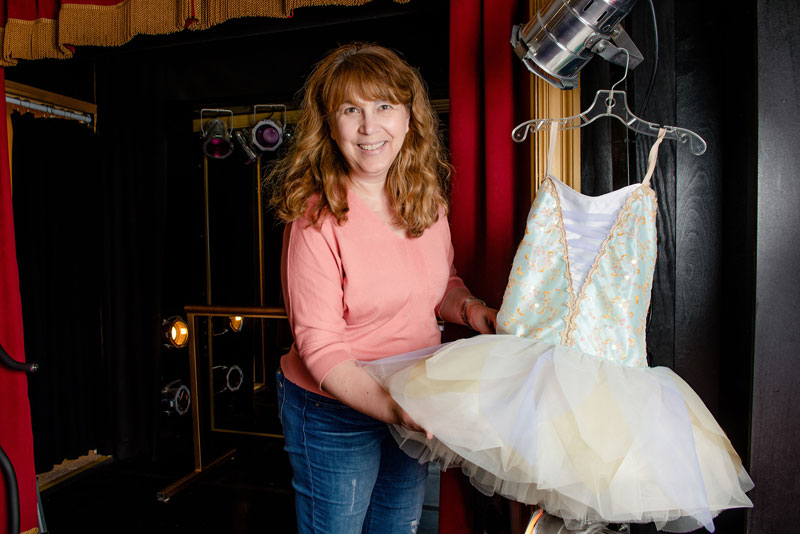by Bonnie Williamson
To dance is to move one’s feet or body rhythmically in a pattern of steps, especially to the accompaniment of music. It comes in many forms, one being ballet. Ballet involves complicated choreography and its performances are found throughout the world. However, most people don’t think ballet or other forms of dance are being taught in some place like West Virginia, the home of country roads and farms. A dance apparel shop for those dancers seems like an even more far-fetched idea. Well, those people are wrong.
Despite the fact that dance had always been a part of her life, Mercedes Prohaska never thought of having her own dance apparel shop or being co-owner of a dance school in the tiny West Virginia town of Shepherdstown.

“I have been a teacher and dance mom for more than 20 years,” Prohaska says, smiling. “But dance was on the back burner for a while. I had a government job in Washington, DC, but I wanted more flexibility in my life. I wanted to be closer to home,” Prohaska says.
Her daughter Harlee became involved with dance, taking lessons at a local dance school in Shepherdstown, three times a week. There, Prohaska became friends with one of the teachers, Emily Romine. When the school relocated and left the area, Prohaska kept hearing from the community that Shepherdstown needed a dance school.
“People knew us. They wanted a dance school they could trust. We decided to make a fresh start on our own. Have high quality teachers. We took over the former dance studio space and started the Shepherdstown School of dance in 2003.”
Shepherdstown School of Dance offers classes in ballet, jazz/modern, and tap. The school currently has 75 students.
“We are committed to keep the art and discipline of classical dance alive in our community,” says Romine.
The school eventually moved to 400 Princess St., but something was missing.
“There was no store in the area where dancers could buy the clothes and supplies they needed. They had to travel to Hagerstown and Frederick in Maryland,” Prohaska says.
So in 2011, Encore Apparel in Motion moved to 108 East Washington St., next door to Shepherdstown School of Dance. Still, there is no pressure for the dance students to shop at Encore.
“They can shop anywhere they like,” says Romine. “But every time I walk through the store, well I love everything.”
Encore has a wide assortment of leotards for children and adults and even gymnastics leotards. There are Capezio tights, dance skirts, dance bags, tap shoes, character shoes for recitals and many other dance supplies all colorfully displayed. Prohaska takes pride in the fact that she has a good relationship with other dance schools, local high schools and universities in the area. She constantly emails her contacts to keep on top of their changing requirements for everyday classes as well as recitals.
“Dance schools have different ‘uniforms,’ like different colored leotards for different age groups. I keep a list of dance school requirements so people never have to guess about what is needed. There are discounts for dance teachers. I provide free professional fittings for individuals and groups. I will travel to other studios to do fittings,” Prohaska says.
And fittings are particularly important when it comes to a very special item of dance apparel: pointe shoes.
“Mercedes is so good at pointe shoe fittings. She really knows what she’s doing and that is so important. We want them to have a quality fit. You can’t get that ordering online,” says Romine.
Prohaska has even been recommended by other dance schools.
Pointe shoe fittings can take from 30 to 45 minutes. Prohaska was certified by the Leap ‘N Learn program in Chicago, a program dedicated to products and information that are sensitive to children’s physical, emotional and cognitive development. Prohaska says being aware of all the ways a child develops is essential.
“Every foot is different. Toe shapes and sizes are different with variations that include toe length and shape, arch flexibility, and mechanical strength. The average age for a student to begin pointe is 12. I make sure the feet are well formed and growth has stopped. If I’m not sure a body is ready for pointe, I have even recommended x-rays to be sure. I won’t sell a pair of pointe shoes if the student isn’t physically ready,” Prohaska says.
Pointe shoes were designed in response to the desire for dancers to appear weightless and sylph-like and have evolved to enable dancers to dance en pointe (on the tips of their toes) for an extended period of time. They are manufactured in a variety of colors, most commonly in shades of light pink.
Since every dancer has unique feet, most pointe shoe manufacturers produce more than one model of shoe, with each model offering a different fit, as well as custom fitted shoes. Regardless of the manufacturer or model, however, all pointe shoes share two important structural features that enable dancers to dance on the tips of their toes: a box within the front end of the shoe that encases and supports the dancer’s toes; and a shank, which is a piece of rigid material that serves to stiffen the sole so as to provide support for the arch.
As well as being the owner of Encore, Prohaska is the only employee except for one part-timer. She says the students she comes in contact with are committed to what they are doing, regardless of the genre of dance they pursue. She shares that commitment in another way. Providing them with the proper tools to accomplish their goals is key for her.
“These young people spend hours and hours in the studio and take extra classes. Dance helps them develop time management and other life skills like discipline. They have a real support system here. They never complain,” Prohaska says.
Encore is open Tuesday, Wednesday and Thursday, noon to 7 p.m.; Friday, noon to 5 p.m. and Saturday, 10 a.m. to 3 p.m.

